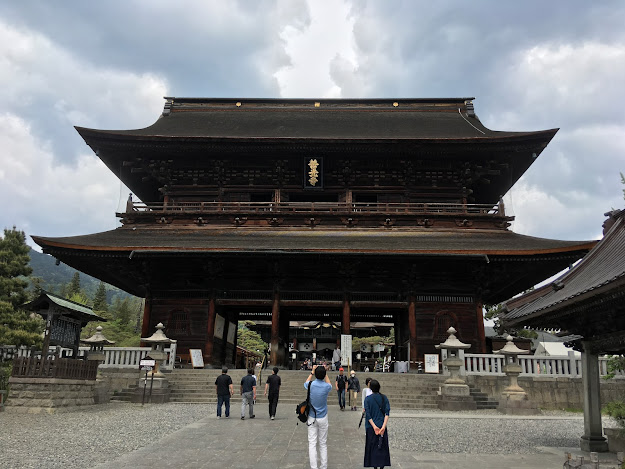Yudanaka is a small town near Nagano known for its hot springs and a major attraction—the snow monkeys that bathe in these springs. Getting to Yudanaka from Sendai was quite an adventure and involved two Shinkansen trains with a transfer in Tokyo, followed by a local “Monkey Express” train from Nagano. The total distance is about 570 km and can be covered in as little as 3 hours and 30 minutes, depending on the departure time from Sendai.
At Nagano Station, it was clear we were in an Olympic city - the host of the 18th Winter Olympic Games. Before boarding the Monkey Express, we bought the Snow Monkey Pass, which for 3,500 yen (about 30 euros) covered the train ride from Nagano to Yudanaka and back, the bus ride from Yudanaka to the Monkey Park, and the park entrance fee itself.
After arriving in Yudanaka, we quickly checked into the Yudanaka Hotel and hopped on a bus that took us close to the snow monkeys. From there, we walked the remaining 2 kilometers through the forest - a gentle and pleasant hike.
Jigokudani means “Hell Valley,” a name it earned due to its volcanic activity, steep cliffs, and harsh, unforgiving winters. To survive the cold, the monkeys huddle together in the trees at night and warm themselves during the day by bathing in the hot spring.
 |
| Geyser on the way to the monkeys in Hell Valley |
The entry rules were similar to those we encountered earlier in Beppu: no touching or feeding the monkeys, and no direct eye contact (as they might see it as a challenge). A new rule this time was the ban on flying drones.
Snow monkeys in May
Since the temperature was a pleasant 20+ degrees Celsius, the monkeys, unfortunately, weren’t too eager to jump into the hot spring… So our experience wasn’t quite the full spectacle—you really need to come in winter for that, although they do bathe on chilly spring days too.
Overall, the monkeys here were more peaceful and less aggressive than the ones in Beppu. They lounged around the water, munched on apples, or simply lazed about. The youngsters put on a show for the tourists, playfully practicing their wrestling moves.
 |
 |
 |
 |
 |
On the way back from the monkey park, we stopped to check out the Tenkawa and Shibuya shrines, as well as a 25-meter-tall statue of the Buddhist goddess Kannon - “she who gazes down upon the suffering of the world.” She watches over Judanaka and is dedicated to world peace. Beside her stands a large bronze bell, whose resonant sound is said to bring peace. Along the way, we also came across blooming cherry blossoms.
 |
| Tenkawa Shrine |
 |
| Our cozy stay at hotel Yudanaka - futons on tatami |
The next day, we made a stop in Nagano itself. Our destination was the Zenkō-ji temple complex, one of the most important and popular temples in Japan. Founded as early as the 7th century, the present-day city of Nagano actually grew up around it.
Deep within the temple lies a very rare and sacred relic - the first statue of Buddha ever brought to Japan. The original, however, is kept hidden from the public, and only a replica is displayed - and even that only once every six years.
 |
| Sanmon gate leading to Zenkó-ji temple |
 |
| Main hall of buddhist temple Zenkó-ji |
In front of the main hall, I witnessed something that truly surprised me - it was the first time I’d seen it in Japan. Buddhist high priests were giving blessings to the gathered crowd as they entered the temple. It all happened rather spontaneously: people noticed the approaching priest, quickly knelt down, and formed a line leading toward the temple. The priest then blessed each person individually.
Inside the temple, there’s also a completely dark underground passage where visitors are meant to search for a key - or rather, a handle - that symbolizes the gateway to paradise and enlightenment. Our journey through the darkness was accompanied by a group of screaming schoolkids 👺.
 |
| Memorial for children with their guardian Kannon, who watches over and protects the souls of unborn or deceased children |
Within the temple complex, there’s also a recently built three-story pagoda that serves as a museum dedicated to the temple’s history. Inside, you’ll find various Buddhist statues and scriptures on display. Admission is 500 yen and includes access not only to the museum but also to the inner hall of the main temple, along with the underground passage mentioned earlier.
 |
| "Wet Buddha" Jizó Bosatsu protects the temple from fire |
As a storm was approaching, we made our way toward Nagano Station. It’s about a 30-minute walk from the temple through the city center. Nagano is famous for its apples - even the local Kit Kats come in apple flavor :)
Summary: Nagano is just under two hours from Tokyo, with Judanaka another 45 minutes beyond Nagano. If possible, it’s best to visit the snow monkeys in winter. Still, Yudanaka is well worth a day trip in any season. The Zenkō-ji Temple in Nagano is steeped in history and offers a truly spiritual experience.
Next blog:




Komentáre
Zverejnenie komentára